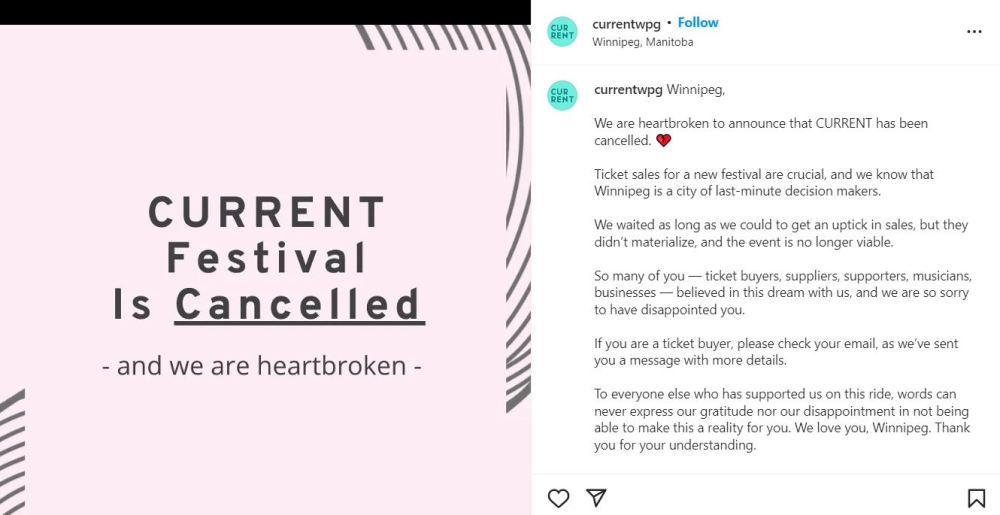Fancy festival forgot fundamentals
Advertisement
Read this article for free:
or
Already have an account? Log in here »
To continue reading, please subscribe:
Monthly Digital Subscription
$0 for the first 4 weeks*
- Enjoy unlimited reading on winnipegfreepress.com
- Read the E-Edition, our digital replica newspaper
- Access News Break, our award-winning app
- Play interactive puzzles
*No charge for 4 weeks then price increases to the regular rate of $19.00 plus GST every four weeks. Offer available to new and qualified returning subscribers only. Cancel any time.
Monthly Digital Subscription
$4.75/week*
- Enjoy unlimited reading on winnipegfreepress.com
- Read the E-Edition, our digital replica newspaper
- Access News Break, our award-winning app
- Play interactive puzzles
*Billed as $19 plus GST every four weeks. Cancel any time.
To continue reading, please subscribe:
Add Free Press access to your Brandon Sun subscription for only an additional
$1 for the first 4 weeks*
*Your next subscription payment will increase by $1.00 and you will be charged $16.99 plus GST for four weeks. After four weeks, your payment will increase to $23.99 plus GST every four weeks.
Read unlimited articles for free today:
or
Already have an account? Log in here »
Hey there, time traveller!
This article was published 09/08/2022 (1225 days ago), so information in it may no longer be current.
It was supposed to be the most attractive music festival imaginable, but then it didn’t happen. It was supposed to have a pop-up restaurant on the main stage, and six-foot chromed mirror balls dangling over luxurious lounge couches. It was supposed to be, in the words of its own Instagram post, “the most Instagrammable festival Manitoba has ever seen.”
If this is news to you, you aren’t alone. When the Current festival, which was set for The Forks this weekend, announced its last-minute cancellation on Monday amidst low ticket sales, the most common reaction was “never heard of it.” Not a good sign for a festival that had staked a lot of money, and most of its vision, on inspiring social media hype.
Yet even if it didn’t make much of a ripple before its demise, this saga is worth considering further. Because the short life and death of Current — which had originally been slated for 2020, but was delayed for the obvious reasons — reveals a great deal about a much deeper problem we face at this cultural juncture, and why we must peel ourselves away from it.

At its heart, the festival contained the seed of a good idea. It was to be a relaxed celebration of local food and local music. It had an exceptional line-up of local artists, including Begonia, Royal Canoe and William Prince; it had developed some cute collaborations with local businesses, including its own signature purple-glazed pastry from Oh Doughnuts.
The problem is, all of that seemed secondary to its main focus, which was neither music nor food, but “vibes.” It leaned on trendy mottos: “unapologetically extra,” its tagline went. It offered a slate of activities, including “bougie lawn games” and mocktail-making classes. “A music festival… but luxe,” its Instagram bio read.
What “luxe” meant, in this case, was an aggressive focus on the event’s aesthetic. In social media posts, it promised “the most photogenic decor you’ve ever seen at a Winnipeg festival,” and praised “the right… selfie backgrounds.” One post exuberantly described how the “brightly coloured cylinders” that would hang around the stage were, in fact, very large tassels.
Nobody has ever gone to a music festival to see fancy tassels. Yet on Friday, when a post on the festival’s Instagram account asked which artist attendees were most excited to see, the only comment was “the decor.” That was as big a sign as any, that Current’s idea of what a music festival could be had become terminally distracted by shiny things.
It wasn’t really selling music, or culture. It was selling the veneer of those things, the image of a good time.
It wasn’t really selling music, or culture. It was selling the veneer of those things, the image of a good time. The impression one got from Current’s marketing was that it was not an event to see, but a place to be seen — and that’s where its good seed was swallowed by the empty maw that consumes so much, in the social media age.
The problem, of course, is that while cute selfies are popular on social media, people want to be able to at least pretend such things are organic. Nobody wants to be seen buying an image; and at $100 for a single-day ticket — roughly as much as Folk Fest, but without the big headliners or diverse experiences — Current had wedged itself into a demographic corner.
There are many in Winnipeg who might have been excited to see those musicians, or nosh on what the food vendors offered. But few want to pay that kind of money to take selfies with chrome beach balls, and when you state so loudly that an event is designed for people who place great value on how they look while doing things, it will turn everyone else off.
In discussions about the cancellation, local music fans who had heard about the festival — it seemed to largely rely on social media for its buzz — described that effect. One person loved the location and the bands, but feared she’d be a “frumpy mom among a bunch of beautiful people.” She wasn’t the only one deterred by similar misgivings.
“Really liked the concept when I initially heard about it,” one person wrote. “Then it just kind of morphed into this ‘influencer’ feeling and I thought, wow, I’m not cool enough for this event and just felt a little too exclusive for me.”
In all of this, it’s hard not to have flashbacks to another, much larger and more infamous disaster: the 2017 Fyre Festival, which pledged a “luxury music festival” in the Bahamas but spawned only total chaos, schadenfreude-filled Twitter posts, United States federal fraud charges, class-action lawsuits and the exploitation of Bahamian workers.
The first lesson of that mess is that scam artistry is bad. I hesitate even to mention its name, because Current’s organizers do not deserve that part of the comparison: there’s no reason to think their effort was fraudulent. They poured their hearts into this event; knowing them mostly by reputation, I believe they love Winnipeg and wanted to bring something special to it.
But there’s one way in which the mention fits, and it’s this. In forging ahead with their vision, even as they must have seen that ticket sales were dismal, Current organizers failed to heed Fyre Festival’s second, and most culturally lasting, warning: social media influencers flog images of an aspirational life, but on some level, we know it’s empty. We don’t believe them.
Luxury, or at least the facsimile of luxury, is largely an illusion. You can’t cultivate community through an aesthetic. You can’t create an experience through selfies.
Luxury, or at least the facsimile of luxury, is largely an illusion. You can’t cultivate community through an aesthetic. You can’t create an experience through selfies. You cannot get folks excited to be part of something new, when you’ve made it clear it’s been curated largely to be a mirror in which they can look at their own reflection.
You also don’t need to. The most popular festivals in Winnipeg include the one where you spend your day overheating on a tarp with filthy feet; the one where you watch indie theatre on folding chairs in bare-bones rooms without air conditioning; and the one where you drink beer in elementary school gymnasiums with other people’s grandparents.
None of those have any lack of advance ticket sales, or of happy attendees sharing selfies.
In other words, you don’t need to be so self-conscious about trying to create something beautiful. What you can always do is stick to the foundations: make a space, fill it with good programming and services, and invite people to come see. Give them places to both discover and create the experience they want to have, and let them shape what the vibe will be.
The sad coda to this story is that a lot of people will be hurt by the sudden cancellation: the organizers who no doubt poured a lot into it, as well as the musicians and vendors who had looked to it for their income. And there was a seed of a wonderful idea for a festival, one that was real and inclusive. Maybe another like it will bloom, if given space to breathe.
melissa.martin@freepress.mb.ca
Our newsroom depends on a growing audience of readers to power our journalism. If you are not a paid reader, please consider becoming a subscriber.
Our newsroom depends on its audience of readers to power our journalism. Thank you for your support.




